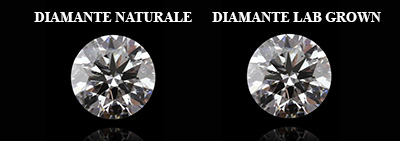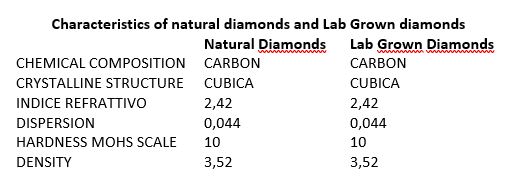Diamonds produced in the Laboratory: Lab Grown Diamonds: How can they be recogni

Lab-produced diamonds have reached a level of composition and quality identical to natural diamonds, from which they are indistinguishable. They just cost less.
Natural diamonds: a minimum of history
Most of the diamonds found on the Earth's surface are believed to originate and have been formed more than a billion years ago in the Earth's mantle, at an approximate depth of 200 km, thanks to a long period of time of thousands of years and of exposure to other temperatures and pressures characteristic of those depths.
Lab Grown Diamonds
Today, rapid technological development allows us to create diamonds in the laboratory with characteristics similar to natural ones, thanks to the possibility of reproducing in a much shorter time conditions similar to those that allowed their formation in nature.
These diamonds are given the name "Lab Grown Diamonds" and there are two processes that allow their formation: the HPHT method (High Pressure High Temperature) and the CVD method (Chemical Vapor Deposition).
Each of the two methods allows you to produce diamonds with different characteristics and, consequently, both are used.
The final product of both methods appears rough and once properly cut and cured is completely indistinguishable from a natural diamond.
To be recognized with certainty, tests must be carried out in specialized laboratories, for example, such as those of the Gemological Institute of America (GIA), where they are analyzed through spectroscopic investigations in the infrared, ultraviolet, X-ray and other wavelengths.
Lab Grown Diamonds that have undergone verification in a GIA laboratory are accompanied by a certification which, in addition to providing detailed specifications on the color and clarity of the stone, indicates the way in which the diamond was grown: HPHT method or CVD method.
HPHT (High Pressure High Temperature) method
For this type of production, a small portion of natural diamond is placed in a structure capable of subjecting it to high pressure (approximately 5-6 GPa, approximately over 50,000 atmospheres) and temperatures between 1300-1600° C.
The environment surrounding the small portion of diamond (defined as the "seed") contains pure carbon in a fluid that facilitates its deposit on the seed, causing it to grow according to the characteristic atomic lattice of the diamond itself.
It should be highlighted that, thanks to this technique, even natural diamonds of lower quality can be subjected to a treatment capable of improving their quality by making them colorless or changing their color to yellow, blue or pink.
In the case of diamonds examined by a gemological institute, such as the GIA, the certification will also contain the information of "treated diamond"
CVD (Chemical Vapor Deposition) method
This process also requires a structure capable of withstanding more moderate pressures and temperatures, in which a diamond plate is placed. The environment also contains gases with carbon elements in suspension which will then be released onto the diamond slab until the formation, over the course of several weeks, of a real diamond, even if rough, as in the previous case.

